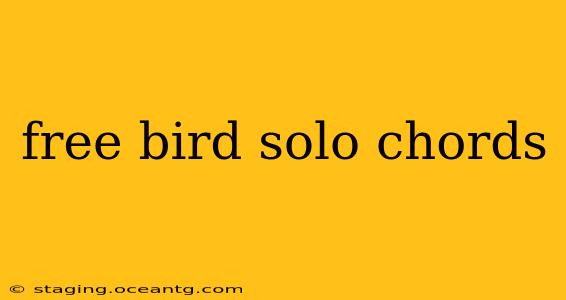Lynyrd Skynyrd's "Free Bird" isn't just a song; it's a cultural touchstone. And the guitar solo? Legendary. While the solo itself isn't based on strict chord progressions in the traditional sense, understanding the underlying harmonic structure is key to both playing and appreciating its brilliance. This guide will delve into the harmonic framework of the "Free Bird" solo, exploring the chords and their relationships to create that soaring, emotional effect.
What Key is the "Free Bird" Solo In?
The "Free Bird" solo primarily resides in the key of E minor. However, Allen Collins' masterful playing frequently modulates and incorporates passing chords, creating a rich tapestry of sound that transcends a simple key signature. Think of it less as a rigid framework and more as a vibrant landscape of musical exploration.
What are the main chords used in the "Free Bird" solo?
While the solo isn't bound to a strict chord progression, the core chords supporting the melodic lines are predominantly variations on E minor. These include:
- Em (E minor): The home base, the foundation upon which the solo is built.
- G (G major): Provides a dominant movement, creating tension and release.
- Am (A minor): A relative minor chord, adding depth and emotional resonance.
- Bm (B minor): A further exploration of the minor tonality, enriching the harmonic palette.
- C (C major): A major chord that adds a brighter feel, offering contrast and unexpected moments of lift.
- D (D major): Another major chord that acts as a transitional element, leading to resolution.
Does the "Free Bird" solo use any other scales or modes?
Absolutely! The magic of the "Free Bird" solo lies in its seamless blending of various scales and modes. While primarily rooted in E minor, Collins expertly incorporates elements of:
- E Phrygian: A mode characterized by its minor tonality and characteristic flat second degree, adding a unique flavor.
- E Aeolian (E natural minor): The natural minor scale of E, providing a melancholic undertone.
- E Dorian: A minor mode with a major sixth, offering a blend of minor and major characteristics.
What are some common techniques used in the "Free Bird" solo?
The "Free Bird" solo is a masterclass in guitar technique. Collins showcases a remarkable arsenal of skills, including:
- Bending: Subtle and expressive bends are used to add emotion and phrasing to the melody.
- Vibrato: A generous use of vibrato adds warmth and sustain to the notes, further enriching the emotional quality.
- Slides: Smooth slides between notes create a seamless flow and add fluidity to the performance.
- Hammer-ons and Pull-offs: These techniques add rhythmic complexity and articulation to the solo.
How can I learn to play the "Free Bird" solo?
Learning the "Free Bird" solo requires dedication and practice. Start by listening repeatedly, focusing on the phrasing and nuances of the melody. Learn the underlying E minor pentatonic and blues scales. Then, gradually work on incorporating the more advanced techniques. Many online resources, including tablatures and instructional videos, can assist you in this journey.
Conclusion: Beyond the Chords
The true beauty of the "Free Bird" solo transcends a simple chord chart. It’s a testament to the artistry of Allen Collins and his ability to weave together a tapestry of sounds, emotions, and techniques to create an iconic piece of musical history. While understanding the underlying harmonic structure is helpful, the real key is to immerse yourself in the music, feeling the emotion and letting it guide your interpretation. Happy playing!
